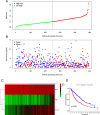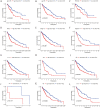A glycolysis-based three-gene signature predicts survival in patients with lung squamous cell carcinoma
- PMID: 34044809
- PMCID: PMC8161559
- DOI: 10.1186/s12885-021-08360-z
A glycolysis-based three-gene signature predicts survival in patients with lung squamous cell carcinoma
Abstract
Background: Lung cancer is one of the most lethal and most prevalent malignant tumors worldwide, and lung squamous cell carcinoma (LUSC) is one of the major histological subtypes. Although numerous biomarkers have been found to be associated with prognosis in LUSC, the prediction effect of a single gene biomarker is insufficient, especially for glycolysis-related genes. Therefore, we aimed to develop a novel glycolysis-related gene signature to predict survival in patients with LUSC.
Methods: The mRNA expression files and LUSC clinical information were obtained from The Cancer Genome Atlas (TCGA) dataset.
Results: Based on Gene Set Enrichment Analysis (GSEA), we found 5 glycolysis-related gene sets that were significantly enriched in LUSC tissues. Univariate and multivariate Cox proportional regression models were performed to choose prognostic-related gene signatures. Based on a Cox proportional regression model, a risk score for a three-gene signature (HKDC1, ALDH7A1, and MDH1) was established to divide patients into high-risk and low-risk subgroups. Multivariate Cox regression analysis indicated that the risk score for this three-gene signature can be used as an independent prognostic indicator in LUSC. Additionally, based on the cBioPortal database, the rate of genomic alterations in the HKDC1, ALDH7A1, and MDH1 genes were 1.9, 1.1, and 5% in LUSC patients, respectively.
Conclusion: A glycolysis-based three-gene signature could serve as a novel biomarker in predicting the prognosis of patients with LUSC and it also provides additional gene targets that can be used to cure LUSC patients.
Keywords: Gene signature; Glycolysis; Lung cancer; Prognosis.
Conflict of interest statement
The authors declare that they have no conflicts of interest.
Figures






Similar articles
-
Identification of a glycolysis-related gene signature associated with clinical outcome for patients with lung squamous cell carcinoma.Cancer Med. 2021 Jun;10(12):4017-4029. doi: 10.1002/cam4.3945. Epub 2021 May 15. Cancer Med. 2021. PMID: 33991070 Free PMC article.
-
Identification of a seven-miRNA signature as prognostic biomarker for lung squamous cell carcinoma.Oncotarget. 2016 Dec 6;7(49):81670-81679. doi: 10.18632/oncotarget.13164. Oncotarget. 2016. PMID: 27835574 Free PMC article.
-
Identification of ALDH7A1 as a DNA-methylation-driven gene in lung squamous cell carcinoma.Ann Med. 2025 Dec;57(1):2442529. doi: 10.1080/07853890.2024.2442529. Epub 2024 Dec 23. Ann Med. 2025. PMID: 39711312 Free PMC article.
-
Primary Lung Squamous Cell Carcinoma With Intestinal Metastasis: A Case Report and Literature Review.Clin Respir J. 2024 Aug;18(8):e13817. doi: 10.1111/crj.13817. Clin Respir J. 2024. PMID: 39118303 Free PMC article. Review.
-
Clinicopathological implications of lncRNAs, immunotherapy and DNA methylation in lung squamous cell carcinoma: a narrative review.Transl Cancer Res. 2021 Dec;10(12):5406-5429. doi: 10.21037/tcr-21-1607. Transl Cancer Res. 2021. PMID: 35116387 Free PMC article. Review.
Cited by
-
Knockdown of lysine (K)-specific demethylase 2B KDM2B inhibits glycolysis and induces autophagy in lung squamous cell carcinoma cells by regulating the phosphatidylinositol 3-kinase/AKT/mammalian target of rapamycin pathway.Bioengineered. 2021 Dec;12(2):12227-12235. doi: 10.1080/21655979.2021.2005931. Bioengineered. 2021. PMID: 34783291 Free PMC article.
-
Determination of a prediction model for therapeutic response and prognosis based on chemokine signaling-related genes in stage I-III lung squamous cell carcinoma.Front Genet. 2022 Aug 31;13:921837. doi: 10.3389/fgene.2022.921837. eCollection 2022. Front Genet. 2022. PMID: 36118890 Free PMC article.
-
Energy metabolism as the hub of advanced non-small cell lung cancer management: a comprehensive view in the framework of predictive, preventive, and personalized medicine.EPMA J. 2024 Apr 8;15(2):289-319. doi: 10.1007/s13167-024-00357-5. eCollection 2024 Jun. EPMA J. 2024. PMID: 38841622 Free PMC article. Review.
-
A Novel Small-Molecule Inhibitor of SREBP-1 Based on Natural Product Monomers Upregulates the Sensitivity of Lung Squamous Cell Carcinoma Cells to Antitumor Drugs.Front Pharmacol. 2022 May 18;13:895744. doi: 10.3389/fphar.2022.895744. eCollection 2022. Front Pharmacol. 2022. PMID: 35662712 Free PMC article.
-
A novel prognostic signature of coagulation-related genes leveraged by machine learning algorithms for lung squamous cell carcinoma.Heliyon. 2024 Mar 5;10(6):e27595. doi: 10.1016/j.heliyon.2024.e27595. eCollection 2024 Mar 30. Heliyon. 2024. PMID: 38496840 Free PMC article.
References
-
- Osmani L, Askin F, Gabrielson E, Li QK. Current WHO guidelines and the critical role of immunohistochemical markers in the subclassification of non-small cell lung carcinoma (NSCLC): moving from targeted therapy to immunotherapy. Semin Cancer Biol. 2018;52(Pt 1):103–109. doi: 10.1016/j.semcancer.2017.11.019. - DOI - PMC - PubMed
-
- Molinier O, Goupil F, Debieuvre D, Auliac JB, Jeandeau S, Lacroix S, Martin F, Grivaux M. Five-year survival and prognostic factors according to histology in 6101 non-small-cell lung cancer patients. Respir Med Res. 2019;77:46–54. - PubMed
MeSH terms
Substances
Grants and funding
LinkOut - more resources
Full Text Sources
Other Literature Sources
Medical
Research Materials
Miscellaneous

